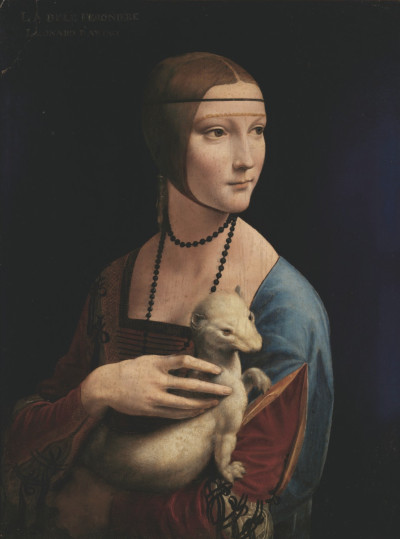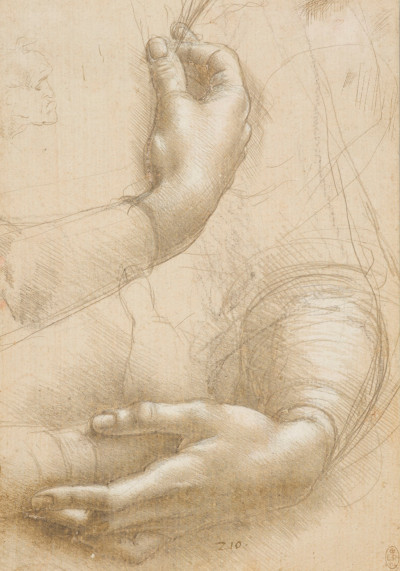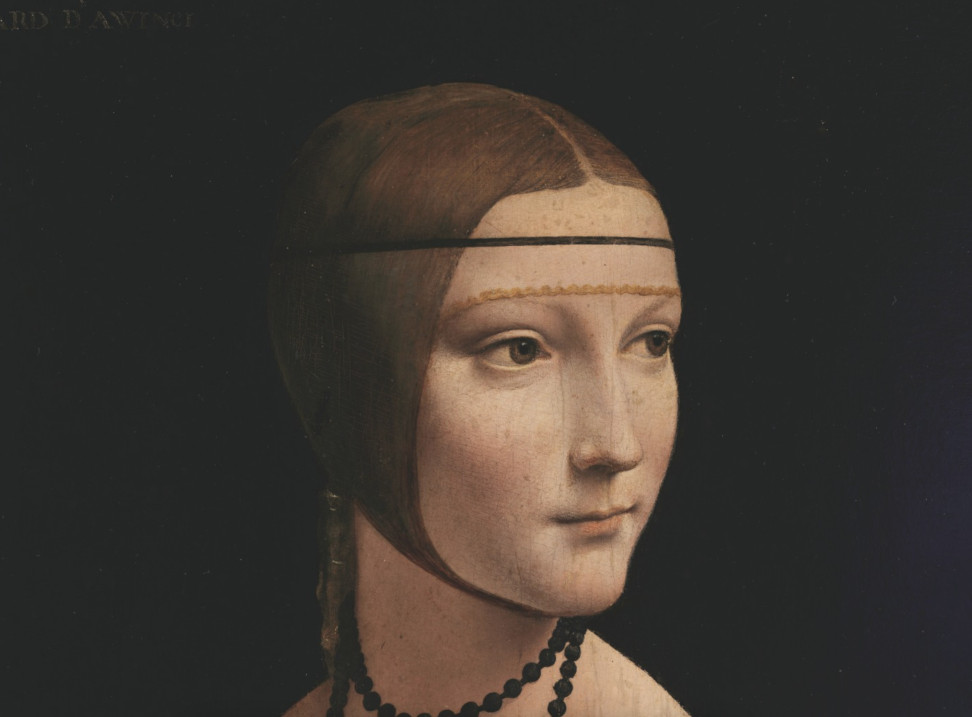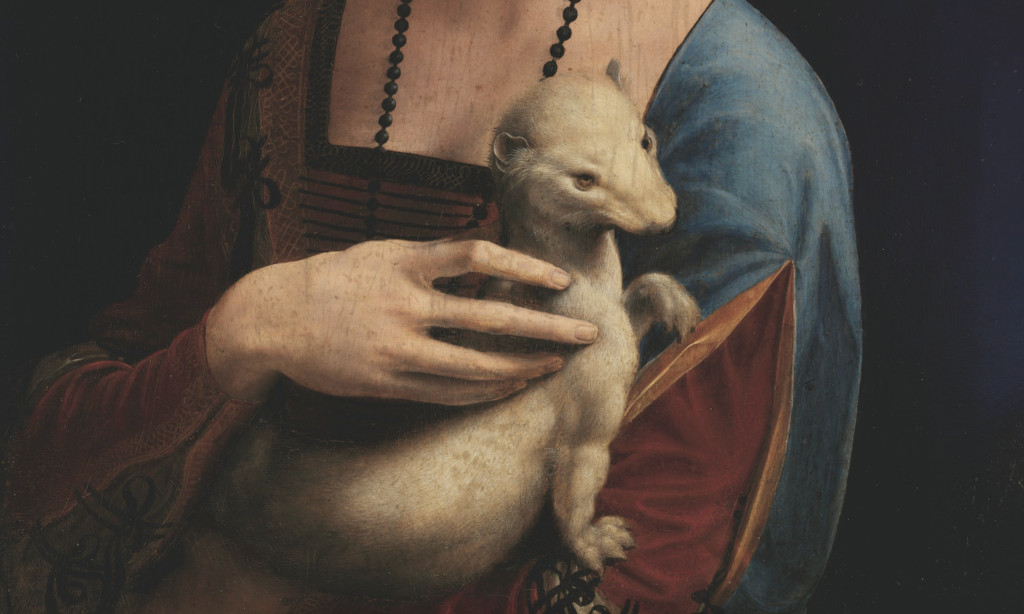Between the years of 1489-1490, artist Leonardo da Vinci produced one of his most respected portraits, capturing a local beauty by the name of Cecilia Gallerani. She would become embroiled in controversy at around the same time, after becoming a mistress to the Duke of Milan, Ludovico Sforza.
The early part of Da Vinci's career was devoted entirely to religious themes, but after his portrait of Ginevra de' Benci from the late 1470s, he would start to alternate between that genre and more contemporary female portraits. Ultimately, this would lead us to his most iconic piece of all, namely The Mona Lisa, but this artwork came about as a result of years of progression, experimentation and artistic discovery. Lady with an Ermine was an important milestone in that journey.
Leonardo da Vinci perfected some painting techniques which produced a more lifelike appearance to his subjects than had previously been seen within the Italian Renaissance. His subtle fusion of glazes would trick the eye into thinking they were viewing reality, and so portraiture would become an ideal genre for this artist to pursue. His reputation was also starting to grow, leading to a wider section of society seeking his services for all sorts of different commissions. Whilst he might turn down some requests, most of his female portraits came from connections in his personal life, and that seemed to be the best way of convincing him to take on particular projects.
"...The ermine out of moderation never eats but once a day, and it would rather let itself be captured by hunters than take refuge in a dirty lair, in order not to stain its purity..."
Leonardo da Vinci
Da Vinci's output might appear a little slow during the 1480s, leading up to his portrait of Cecilia Gallerani and the Ermine, but in truth, he was already looking into other disciplines that would broden his oeuvre, and a number of his paintings from this period may also have been lost or mis-attributed in the years that have passed since. The artist would sketch frequently, for example, and some of animal drawings would be used together to create his version of this Ermine, with most experts pointing out its divergence from reality. He was seeking symbolism with this interpretation, rather than anatomical precision.
The fame achieved by Leonardo da Vinci, becoming one of the most famous artists of all time, has led to an incredible amount of research being completed on his career over the past few centuries. We know so much about the women in his portraits today, providing a backstory to his more well known artworks. The latest development had been through scientific research, which has enabled experts to look below the surface of each artwork, uncovering stages of development and even alterations that were made by the artist and others afterwards in the process of restoration.
The article below examines every aspect of Leonardo da Vinci's Lady with an Ermine, including the techniques used to produce this stunning portrait, as well as the journey that it has endured in the centuries since. Thankfully today it remains in excellent condition and is seen by many as one of his finest portrait paintings. The item resides in a gallery in Poland, attracting admirers from across the globe who continue to discover the oeuvre of this critical European painter, draughtsman and inventor - a true Renaissance master.
Table of Contents
- Who was Cecilia Gallerani?
- Leonardo da Vinci's Portraits
- Commission
- Preparation
- Stages of Development
- Analysis
- Medium & Size
- Attribution
- Timeline
- Location
- Facts
- Value
- Close-ups of the Painting
- References
Who was Cecilia Gallerani?
Cecilia Gallerani was born in Siena, Italy in early 1473, living until around 1536. She would therefore have been around 16 at the time that she sat for this portrait. Her beauty was well known locally, and she was also respected for her knowledge of poetry and literature more generally. As was common for women at the time, she did not enjoy a full independance, and was initially betrothed to Stefano Visconti, when aged just ten. She was able to escape this commitment and headed to the Monastero Nuovo. She would later become the most famous mistress of Ludovico Sforza, Duke of Milan.
Beatrice d'Este would marry the Duke and immediately set about removing Cecilia from the picture, which she successfully managed to do. Gallerani would marry Count Ludovico Carminati de' Brambilla, "Il Bergamino", and have four children with him. She continued to hold a strong interest in art, literature and music throughout her lifetime and sensbily lived a more low-key life after being distanced from the Duke.
Leonardo da Vinci's Portraits
Leonardo da Vinci produced four female portraits over a period of around 25 years, and there are many similarities between them. Compositionally, Ginevra de' Benci (c. 1474–1480), the first of the four, is the boldest, with the subject brought forward in a manner that dominates the scene. The three that then followed, Lady with an Ermine (c. 1489–1491), La Belle Ferronnière (c. 1490–1498) and Mona Lisa (c. 1502–1516), would all pull the sitter back somewhat, allowing more space and detail around the subject. The facial expressions and physical characteristics of the women are similar throughout, and created something of a signature look for his portraits.
The artist had a precision and accuracy to his portraits which immediately set him out from all other portrait painters in Italy at that time. Religious themes had dominated the artistic output for centuries, but the likes of Da Vinci were starting to change this by broadening their oevures, and encouraging others to do the same. Success brought attention to Da Vinci's portraits, and led to further commissions coming in from different sections of Italian society. Da Vinci was a hard working and curious artist who continued to work in different genres for years to come, whilst also finding time to take on other disciplines such as invention, drawing, mathematics and literature.
Commission
Leonardo da Vinci worked for Ludovico Sforza from 1482-99 and it was the Duke of Milan who commissioned Lady with an Ermine. Cecilia Gallerani had only recently become one of his mistresses, at the age of around 15, and he adored her. She would become his most famous mistress of all, and clearly the Duke wanted to celebrate her beauty through this portrait. He would have been aware of Da Vinci's considerable talents in portraiture, as well as his growing versatility as an artist, and so was keen to use his services for this particular piece.
Any payment received by this artist for this portrait would have been a part of his overall employment with the Duke, and no records have been found regarding payment for this painting specifically. Whilst working for an employer in this manner would sometimes have restricted Da Vinci's freedom of expression, it did provide financial security which was a rarety for artists at that time, even in the culture-rich Italian cities of Florence, Venice, Rome and Milan.
Preparation
There are several hand study drawings by Da Vinci which were incorrectly linked to his portrait of Ginevra de' Benci and are actually liked to have been produced whilst preparing for his portrait of Cecilia Gallerani. Of course, the final composition of the oil painting does not match these sketches, but they are likely to have come early on, before it was decided to add the Ermine. The artist would regularly practice his understanding and depictions of anatomy in any case, and so it would have been entirely routine for him to sketch parts of the body in this manner. The hands themselves are separate, placed together on the same paper just to save resources.
Many of the artist's learnings for this piece would have actually come in previous oil paintings, particularly his famous portrait of Ginevra de' Benci. It was then that he started to experiment with different postures, and to experiment with non-religious themes for the first time. Many of the elements in that painting can be found here, such as how the face and body are not angled in the same direction. The two models are also of approximately the same age and appearance. Additionally, the two models are dressed fairly modestly, with elegance but no great abundance of jewellery or extravagant flourishes of design.
Stages of Development
Scientific research into this painting has revealed much about the different stages of development which were carried out by the artist. Initially, the ermine was not even included and the background was an entirely different tone. He would later add it after much of the rest of the painting was complete, but then continually amended the creature, enlarging it as he went. The ermine was also originally grey, before being transformed into the brilliant white which may have delivered a symbol of purity to the piece. Many historians still argue about the precise meaning of the creature, and it is unlikely that any firm conclusions will be agreed upon all these years later.
We already know that the artist produced some intial studies in chalk and charcoal prior to starting this portrait, and he would then have drawn out the composition directly onto the wood, before painting layers over the top. These initial underdrawings appeared in x-ray studies of the painting and also help to compare the original intentions of the artist, with the final result. Some have suggested that a window was originally added into the background, just behind the model, but no evidence of this has yet been found.
Analysis
Technique
Two powerful painting techniques found across the Renaissance can also be located in the work of Leonardo da Vinci, namely chiaroscuro and sfumato. The former allows a three-dimensional appearance to be formed within visual art through the careful use of shadowing, whilst the latter refers to the subtle use of tonal work which ultimately can produce a life-like image. In later centuries the use of chiaroscuro would become much bolder and more aggressive, leading to some dramatic effects, but Da Vinci preferred to be more restrained in his approach. Da Vinci uses sfumato within Lady with an Ermine, just as he does with all of his other female portraits, and he remains the most famous name connected to this particular technique. It was also employed by other major artistic names such as Correggio, Raphael and Giorgione as well as many of Leonardo's own followers.
Style
Leonardo da Vinci brought many new ideas into Renaissance art, as well as expanding on what had already gone before. He loved to bring movement into his compositions, which he managed by altering the postures and angles of his subjects. Earlier periods of the Renaissance had been remembered for flat content and Da Vinci wanted to incorporate a greater depth into his paintings. Shadows and a careful use of composition allowed him to do this, although Lady with an Ermine is not the best example of that. He also brought elements of landscape art and portraiture to the fore, with few religious connections in some of his work, opening up new opportunities for the next breed of artist. Whilst he regularly called upon on religious themes in his work, sometimes out of necessity to please the donor, he did not restrict himself entirely to this genre as others had done.
Composition
The triangular format of this portrait is entirely typical of the Renaissance era, but what is unusual is in how Da Vinci angled the heads and shoulders in different directions. This creates a feeling of movement, which was something that interested the artist throughout his career, but it also adds an element of mystery to the composition as well - who, or what is the young lady staring at? It leaves yet another question mark for us to ponder, with little change of finding an answer. The decision to leave the background entirely devoid of detail goes against his earlier portrait of Ginevra, but allows the foreground to entirely dominate our attention.
The three-quarter length portrait was rarely seen in the Renaissance, and can be considered another of Da Vinci's artistic innovations. If we compare his female portraits over a period of several decades, there would be many signature elements that persisted throughout, but also some diversions and differences as he continued to develop and experiment as an artist. He may also have had some interference and direction from his donors and also the sitters, and how they wanted each piece to progress.
Meaning
Most discussion surrounding this portrait has centered on the meaning of the ermine. We do know that it was added relatively later in the painting's creation, and some have argued that it represents the lady's lover, The Duke of Milan. Perhaps she wanted the entire court to be aware of their relationship, and the enlarging of the creature may have been for the purposes of flattering the Duke. Of course, this is just one of many theories that have been put forward over the years. The main focal point is a pretty young woman, and that part of the portrait serves simply as an aesthetically pleasing, complementary work, just as with his other female portraits from around this part of his career.
We also know that the ermine was originally grey before being whitened and this could well have been for symbolic purposes, bringing a sense of purity to whoever or whatever was represented by the creature. Leonardo da Vinci did leave some ambiguities with his paintings that have allowed room for discussion in the centuries that have passed since, and Lady with an Ermine is no different in that regard. The connection between Cecilia Gallerani and her famous lover would inevitably focus the minds of historians when studying this piece, but there remains little information on who was directly involved in planning the composition, other than the artist himself.
Influence
Da Vinci was most influenced by his connection to the school of Andrea del Verrocchio, who in turn was a pupil of the legendary sculptor, Donatello. The young Leonardo was able to discover a wide breadth of skills whilst working under the wing of Andrea and this encouraged him to develop his knowledge over many different disciplines over the course of his lifetime, including drawing, invention, painting and literature. He would also travel to different parts of Italy across his lifetime, which brought him into direct contact with a mixture of artists, who came from regional schools which each had their own unique characteristics.
As a further note, in building strong relationships with notable patrons, Da Vinci would also have got the opportunity to study some of their own collections, some of which were rather impressive. He would have come into contact with highly prized sculptures and paintings, as well as some extravagant architecture in which many of these wealthy individuals would live.
However, in terms of influences upon The Lady with an Ermine, most comes from the artist's earlier portraits, and the various artistic techniques which he had already mastered in previous decades. It was those which helped him to produce photo-realistic images that immediately marked his work out from the rest of the Renaissance. He would continue to switch between portraiture, religious themes and other disciplines for years to come, ensuring he never lost touch with any of the skills that he had mastered in earlier years.
Medium & Size
The Lady with an Ermine was completed using oil on walnut panel, somewhere between the years of 1489–1491. It is a typically small portrait, sized at just 54 cm × 39 cm, or 21 in × 15 in. This painting is almost identical to the original portrait of Ginevra de' Benci, before it was cut down due to damage in the lower half, and approximately the same as two other related Da Vinci portraits, namely La Belle Ferronnière and the Benois Madonna. However, as the artist's career progressed he would start to produce much larger canvases, partly due to where they were intended to be hung.
Attribution
As with many of Da Vinci's portraits, Lady with an Ermine was not conclusively attributed to the artist until relatively recently. It came under greater scrutiny during the 20th century as a result of a forced relocation and this was when its connection to Da Vinci started to strengthen. Modern scientific research techniques have advanced so much in recent years that most historians are now confident of its origins, and also consider it to be one of Da Vinci's finest paintings.
With this connection now confirmed, more recent research has started to go further into the processes of development used by the artist. X-Rays have suggested alterations made by the artist, whilst also helping to reject older theories such as what might have been on the wood initially, before being painted over. For example, the background was re-done, and there may have been details within it at some point, before being delivered in the flat tone that still remains today.
Timeline
The painting is dated to around 1489-1490, although art historians sometimes argue over the precise time span. Da Vinci was starting to work with secular portraits for the first time at around this point in his career, with his portrait of Ginevra de' Benci coming around a decade earlier. He also constructed a portrait of a musician several years earlier, though some pieces may have been lost at around this time, because of the gaps that exist in his output from 1485-1489.
The artist was still completing religious commissions, though, and was switching between the two genres fairly regularly at this point - for example we can find La Belle Ferroniere from the early 1490s as well as The Virgin of the Rocks (National Gallery, London version) and The Last Supper from just a few years later. It must also be remembered that Da Vinci was from just a painter, and he would also have been looking into other disciplines at this time as his curious mind continued to run wild.
Location
The Lady with an Ermine can today be found at the Czartoryski Museum in Kraków, Poland. It was acquired as recently as 2016, having been passed down through generations of the wealthy Czartoryski family ever since the late 18th century. Its journey up to that point is a little more unclear, partly because it was not correctly attributed to Da Vinci until it had left Italy for Poland. A price of €100 million was paid to the family by the Polish government, with Adam Karol Czartoryski being the last decendant to own the piece personally. It can be considered the most valuable artwork in the country currently and is an important attraction for visitors to the city of Kraków.
Exhibition History
Whilst remaining in a private collection in Poland up until 2016, the painting has actually featured in foreign exhibitions many times over. Within the 20th century, no other artwork from Da Vinci has been found in as many countries as Lady with an Ermine. Thankfully, the piece remains in excellent condition and great care has been made to ensure that these short term loans have not led to any deterioration in the centuries-old painting.
Some of the highest profile exhibitions in which it would appear include Warsaw (1952), Moscow (1972), Washington D.C. (1991/1992), Malmo (1993/1994) and Rome/Milan/Florence in 1998-1999. Today it resides in the Polish city of Kraków, under the ownership of the Polish Goverment and remains a major attraction for art tourists elsewhere in the country and abroad.
Facts
See below a collection of facts that we have uncovered about this famous painting:
- The portrait is of Cecilia Gallerani, a mistress of Ludovico Sforza, Duke of Milan
- Leonardo da Vinci completed The Lady with an Ermine at some point between the years of 1489–1491
- It is one of only four female portraits by Leonardo da Vinci to survive to the present day
- Art historians only realised it was by Da Vinci in the 20th century
- It is amongst the most travelled of the artist's paintings, having featured in exhibitions in Italy, Sweden, Russia and the USA.
Value
The painting was sold for €100 million in late 2016, though it is likely that its true value would be far higher were it sold in a public auction. The Czartoryski family, who had owned it since 1798, clearly wanted it to remain in Poland, and available for public viewing. Other Da Vinci paintings have sold for up to five times the price as this in recent years, and so this much loved piece could be valued at something more like $150-200m were it ever to come up for auction.
Close-ups of the Painting
In order to truly appreciate the subtle brushwork added by Da Vinci in this painting, we have included two close-ups of the painting below. The first focuses on the face of the model, Cecilia Gallerani, whilst the second concentrates on her hands, and the Ermine which she tightly grasps. Few will be able to visit the piece in person, sadly, and so this is the next best alternative in order to enjoy the brilliance of the artist, in what is one of his most famous paintings. Several recent publications have also released large prints of the original work, placed alongside detailed texts about the work, and one of the best is listed in our references section at the bottom of the page.
Head of the Model
Here we see a close-up of the young beauty's face, featuring a pale complexion that was particularly popular within Italian society at that time. She stares off to the right, and not directly at the viewer in a manner the artist tended to avoid in most of his portraits. She bears the same serious expression, almost smiling but not quite, as seen in his iconic Mona LIsa and elsewhere. Some have suggested that she is actually staring at her lover, but this cannot be confirmed. Cecilia wears a silk sbernia, and other flourishes in her clothing, though is relatively modestly dressed for this portrait.
The Ermine
Those familiar with Ermines have declared this depiction of the animal unrealistic, suggesting that Da Vnci's approach was to provide a symbolic addition to the composition, rather than working in a purely realist manner. Its stunning white coat may have represented purity on the part of the lady in the portrait. Indeed. the artist's reproduction of this animal features elements of other animal sketches that he produced at around the same time, making it something of a mythical creation that should be judged within that in mind. Comparisons can also be made with how his other artworks around this time featured Madonna holding child, with similar postures.
References
- Leonardo. The Complete Paintings and Drawings, Frank Zöllner & Johannes Nathan, Taschen
- Leonardo da Vinci, Walter Isaacson







